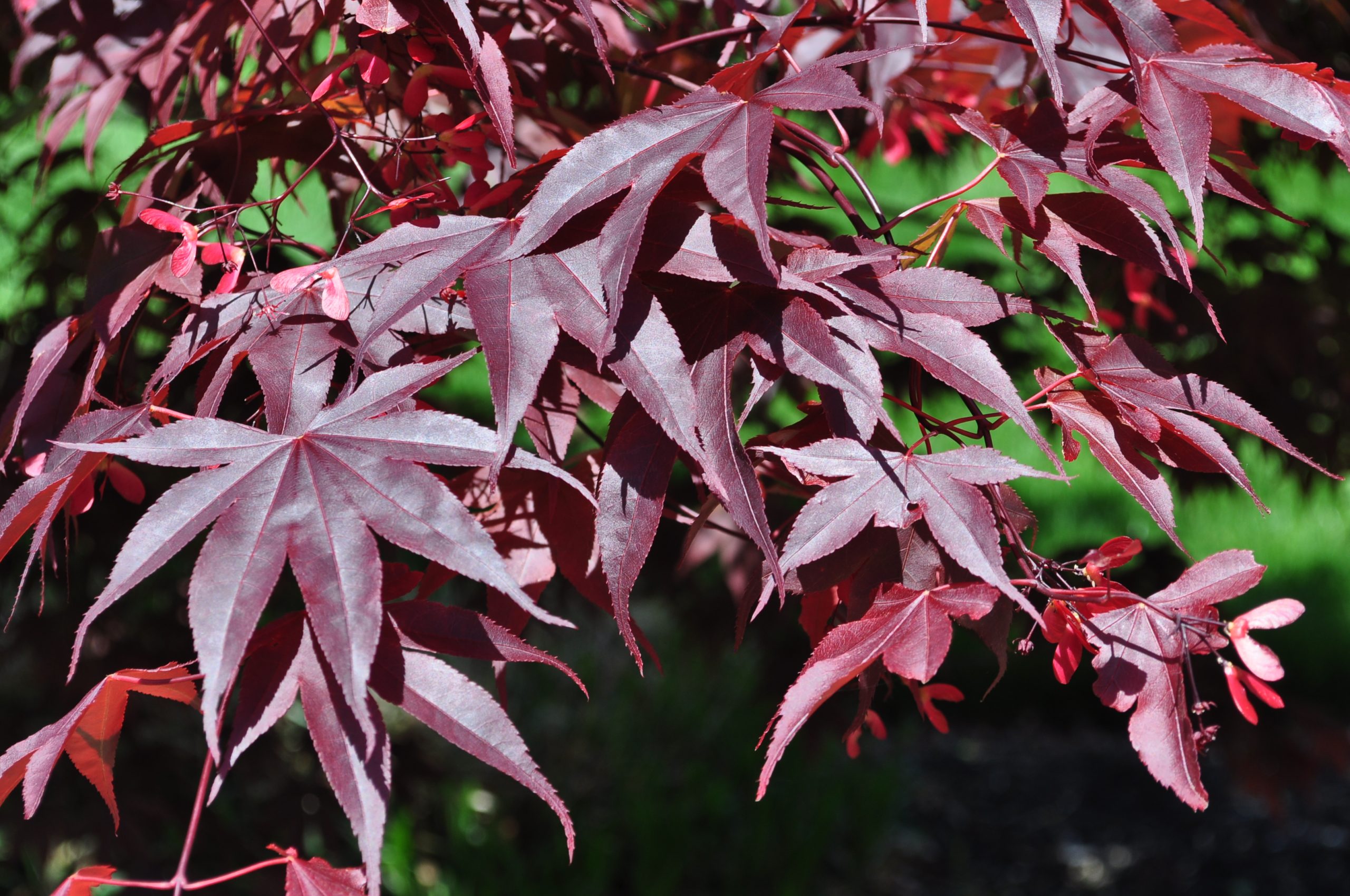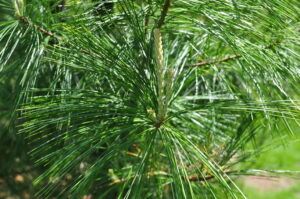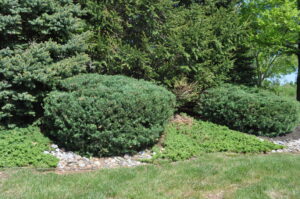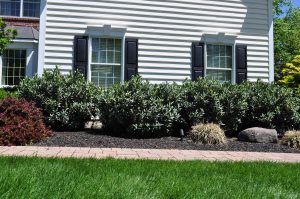Popular plants in New Jersey

There certainly is a reason New Jersey is called the Garden State, as the state is covered in beautiful native trees and shrubs. Below we discuss some of the most popular trees and shrubs in New Jersey and information about each one that is helpful for homeowners to understand and best choose what landscape plants they wish to have on their property.
Popular Trees
Flowering Dogwood
A common ornamental tree that grows between 20 to 40 feet in height with white, pink and most recently scarlet fire (the first red dogwood). Its fruits are small red clusters that ripen early in the fall. These are usually food for deer, wild turkeys and squirrels. Also, there is a Kousa Dogwood that has become popular as well. This type of tree is very similar to the Flowering Dogwood in size, shape, color and differs with its fruit. A Kousa Dogwood grows red marble-sized berries instead of the red clusters.
Weeping Cherry
This tree grows between 20 to 30 feet tall and spread out to about 15 to 25 feet. They bloom beautifully in the spring time that produces wonderful pink to white colored blossoms. The bark has distinctive circular rings along the trunk of the tree.
Plum
Plum trees produce beautiful pink and white blossoms in the spring and then maintain a vibrant deep purple color throughout the year. A plum grows to 25 feet and at peak maturity reach 25 feet wide. These trees are excellent for full sun and can tolerate moderate heat stress.
Japanese Maples
Japanese Maples are one of the most common trees planted in a landscape. Japanese Maples have been cultivated for over 300 years. This tree reaches 15 to 25 feet in height. The leaves are about 2-5 inches and turn from a green color to a maroon. Some varieties can yield yellow, bronze, purple or red leaves in the fall.


Saucer Magnolias
Saucer Magnolias are large in size and have pearly white to pink or purplish bell-shaped flowers. The petals fall off very early in the spring due to a frost or particularly cold night. There are other types of magnolias in our area such as the Star Magnolia and the Southern Magnolia that are popular to our area.
Red Buds
These trees often reach 20 to 30 feet in height and spread to 25 to 35 feet. With its broad heart-shape leaves and rosy pink with a purplish tinge flowers makes this tree a great addition to any landscape.
Pears
Originally introduced as a fruit tree, pear trees quickly became popular as an ornamental tree in landscapes and street trees. The flowers are described as “clouds of white blossoms.” One downside of pear trees is they tend to split at the crotches of weak branches during windy weather or when they have heavy loads of snow upon them.
Douglas Fir
Known to be the most popular evergreen for Christmas trees. They are used in home landscapes where they can grow to be up to 300 feet tall. These trees should not be planted close to houses because of how tall they can get.
Hemlocks
Hemlocks grow 70 to 100 feet and have soft slender branches that produce small ½ – 1 inch cones and referred to as one of New Jersey’s most “graceful” trees.

Norway Spruces
Norway Spruces have been one of the most widely cultivated species for its use in landscapes and reforestation in New Jersey and also used as a windbreak for farmland. Norway spruces are mostly recognized for the large cones that hang from the branches. These cones can grow over 2 inches in length.
Blue Spruces
Otherwise known as a Colorado Spruce, blue spruces are Colorado and Utah’s state tree and are native to the Rocky Mountains. Known for their dull green or bluish to silvery white colored needles, they typically grow between 30 to 60 feet tall in landscapes and can reach 100 feet in the wild.

White Pines
White Pines are the only pine that have 5 needles per bunch. These trees were once used for timber and usually grow between 50 to 80 feet tall in a landscape setting and can grow over 200 feet tall in the wild. White pines are very recognizable from a distance and used in reforestation and as buffer trees, like seen in the image below.


Arborvitae
Arborvitae are another of the most common trees planted in a New Jersey landscape. Typically this plant acts as a privacy buffer for home lawns and are easy to maintain. The name arborvitae translates to “tree of life.” This tree is long lived and has a high amount of vitamin C in the leaves.
Popular Shrubs
Azalea
Azaela come in both fragrant and non-fragrant varieties. This plant’s colors vary from perfect pink to white funnel-shaped flowers that are at their peak by mid-May. They are chosen for their size and beauty. Azaleas in our area can grow 3 to 4 tall and wide.
Holly
Holly are mostly known as mistletoe. These plants should be planted in pairs of 2 or more so they can cross pollinate to produce the beautiful red berries they are known to have. They grow between 15 to 18 feet in height. They were said to be a favorite of George Washington and some of the hollies he planted are still around to this very day.
Inkberry Holly
Inkberry Holly related to the holly species and most notably identified in the winter time when its leathery, notches, green looking leaves and black fruits are present. Relatively free of insect pests and diseases, the Inkberry Holly make a great shrub to have in a landscape.
Rhododendron
Rhododendron which means “rose tree,” produces beautiful rose to white colored flowers that are spotted on the inside with yellow or orange. The leaves can be large with thick, oblong and an evergreen color. These flowers are considered “nectar rich” which attracts butterflies, bees and moths. This shrub grow between 4 to 15 feet in height with the flowers blooming in late June through late July. Rhododendron are related to azaleas and prefers areas that are shaded but still get some sun.
Juniper
A global type shrub that exists everywhere. It does not exceed six feet in height and serves as a nesting place for small mammals and birds. The blue to black colored berries, which reach ripening in October, are primarily used as the main flavoring of Gin. In the picture below, notice the two varieties of Juniper; the low to the ground variety and the larger shrub.

Boxwoods
The most common landscape shrub in our area today. Almost every landscape has boxwoods present. This is due to its adaptability to any soil type. A boxwood’s small, simple rounded leaves are easily sheared for pruning and last year-round. They are ideal for every landscape because they contain a toxic alkaloid that makes the plant unpalatable to deer and other wildlife.


Golden Threaded Cypress
A “golden mop” used frequently in landscapes due to their vibrant golden or yellow color. Also, this conifer is small in stature and grows slowly reaching about 3 feet tall. The leaves resemble a mop or threads.


Burning Bush
Otherwised knows as a “winged euonymus”. This shrub grows to about 10 to 15 feet tall and identified by its “corky-winged” branches. Most of the year the leaves are green and in fall they turn a bright deep red color before dropping all its leaves off for the winter.


Barberry
Barberry a small 2 to 6-foot plant. This shrub has green leaves that turn to a red, orange or purple in the fall. It develops bright red berries and has small spurs or thorns on its stems which makes it undesirable to deer or other mammals.

Spirea
Spirea is also known as the “bridal wreath” and can grow up to about 6 feet in height. They have stunning- clusters of white, yellow, pink or purple flowers. People plant spirea in landscapes for their ability to act as a shrub border, ground cover or hedge.

Forsythia
Forsythia are often associated with the coming of spring and are known for light or deep yellow colored flowers.
Laurels
Laurels are a very versatile shrub. They’re a popular evergreen with green broad glossy leaves because they can thrive in shade or sunny areas. They produce small white flowers in the spring. They are commonly used as a border or boundary and privacy due to their dense-like nature. They usually grow to a height of 10 to 12 feet.


Pieris
Pieris or often called “Andromeda”, foliage changes color throughout the season and has long dangling multicolored buds that open to creamy-white blossoms in the spring. This shrub reaches 6 to 8 feet in height and be a focal point or integrated with other shrubs in your landscape. Additionally, Pieris tend to grow very slowly and are beautiful.
Where to plant?
For many homeowners, deciding where to place landscape plants can be a tedious process. In order to make that process easier, we put together the most important factors to deciding to plant the right plants in the right place. Feel free to give our office a call with any questions, our tree and shrub experts are happy to help in any way they can.
Conclusion
These are just some of the trees and shrubs that are popular in New Jersey. There are many other types of plants that we see. If you have any of these plants and want information on caring for them, check out our tree and shrub program. If you have any questions or if you are in our area and would like a free estimate, please call or click here.




